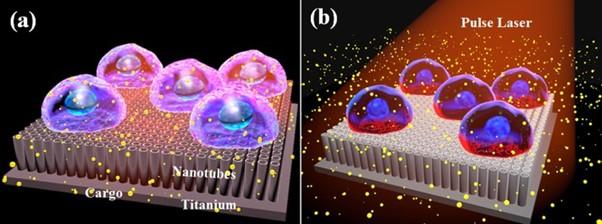
Credit: COPYRIGHT (C) 2015 TOYOHASHI UNIVERSITY OF TECHNOLOGY. ALL RIGHTS RESERVED
Overview:
A research team at the Department of Mechanical Engineering at Toyohashi University of Technology developed a nanosecond pulse laser-assisted photoporation method using titanium-oxide nanotubes (TNTs) for highly efficient and low-cost intracellular delivery. The proof of concept for the possibility of intracellular delivery after irradiation with nanosecond pulse laser on TNTs was validated. TNTs were formed on titanium sheets using the electrochemical anodization technique at different voltages and times. HeLa – human cervical cancer cells were cultured in the nanotubes and submerged in a solution of biomolecules. After cells were exposed to nanosecond pulse laser, we successfully delivered propidium iodide (PI) and fluorescent dextran into cells with high efficiency and cell viability.
Details:
A research team at the Department of Mechanical Engineering at Toyohashi University of Technology developed a nanosecond pulse laser-assisted photoporation method using titanium-oxide nanotubes (TNT) for highly efficient and low-cost intracellular delivery. The results of their research will be published in the Applied Surface Science on 30 March 2021, 148815. (Available online 24 December 2020).
The potential to deliver external molecules into living cells with high cell viability and transfection ability is of great interest in cell biology for diagnostics, drug delivery, and therapeutic development towards cell therapy and regenerative medicine. Over many years, drug delivery systems have advanced to attain more control of drug dosage, targeted delivery, and reduced side effects. These techniques can be classified as viral, physical, or chemical methods.
Among these methods, photoporation is emerging and has become popular for intracellular delivery in the last few years, owing to less invasiveness. In this method, gold nanoparticles, which absorb pulsed light, are dispersed in a solution to perforate the cells, however, the materials are expensive. It is desirable to use nanomaterials that are less expensive while maintaining high delivery efficiency and cell viability.
The research group designed and fabricated a cost-effective nanotube array for photoporation based intracellular delivery. TNTs were formed on titanium sheets at different voltages and times using the electrochemical anodization technique. X-ray photoelectron spectroscopy (XPS) revealed the presence of different titanium oxide species such as TiO2 and TixOy (TiO/Ti2O3/Ti3O5). TNTs formed by different anodization voltages and times had different concentrations of such oxidation species along with a minor quantity of Ti metal (Ti0). Owing to the formation of oxygen defects, nanotubes have quasi-metallic and metallic properties. These properties of the nanotubes may facilitate the intracellular delivery by various mechanisms after irradiation with a nanosecond pulse laser.
HeLa – human cervical cancer cells were cultured on TNTs and a biomolecular solution was introduced. After exposure to a 532-nm pulse laser on nanotubes, we successfully delivered propidium iodide (PI) and dextran into the HeLa – human cervical cancer cells with high efficiency and cell viability.
Possible principles of cell membrane perforation include thermal-mediated nanobubbles, photochemical induced reactive oxygen species (ROS), heat transfer from nanotubes to the cell membrane, and localized surface plasmon resonance high electromagnetic field enhancement on each nanotube. This leads to the formation of cavitational nanobubbles in each cell membrane-nanotube interface that may rapidly grow, coalesce, and collapse to cause explosions, resulting in cell membrane perforation, which enables biomolecules to be delivered from the outside to inside the cells. “The precise mechanism for the intracellular delivery on TNT-based photoporation is still unclear. Intracellular delivery may happen by the combination of the mechanisms,” says L. Mohan, a researcher, at Toyohashi University of Technology.
Moeto Nagai, the team leader, at Toyohashi University of Technology, believes that titanium oxide nanotubes could be a versatile and low-cost platform for intracellular delivery using pulsed laser. This device’s prominent features have parallel and controlled uniform delivery with high efficiency and cell viability and it is potentially applicable for cellular therapy and regenerative medicine.
###
Funding agency:
This work was supported by JSPS KAKENHI Grant Numbers 16H06074 and 20H02115 and JSPS Postdoctoral Fellowship for Research in Japan and by the Leading Initiative for Excellent Young Researchers, MEXT.
Reference:
Mohan, L., Srabani Kar, Ren Hattori, Miho Ishii-Teshima, Parthasarathi Bera, Sounak Roy, Tuhin Subhra Santra, Takayuki Shibata, and Moeto Nagai. “Can titanium oxide nanotubes facilitate intracellular delivery by laser-assisted photoporation?” Applied Surface Science, Volume 543 (2021) 148815:
http://www.
Media Contact
Yuko Ito
[email protected]
Related Journal Article
http://dx.




